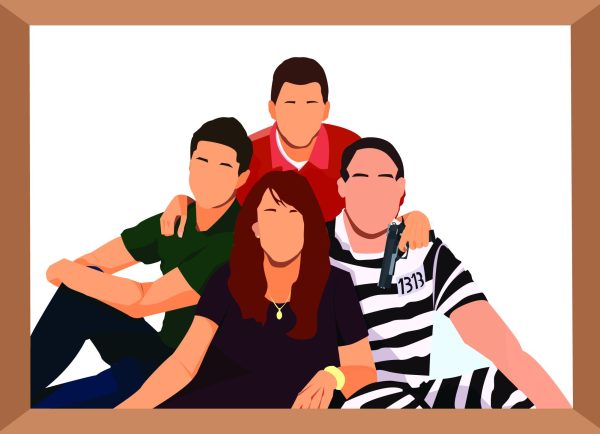Shifts and Shortcomings
A look at the impacts and insufficiency of police reform after the 2020 BLM protests
JUSTICE. A large group of protesters pass by a police officer during a Black Lives Matter March near Town and Country Village in Summer 2020. Photo by Corie Jiang.
May 28, 2021
On May 25, 2020, George Floyd, a Minneapolis native and black man, died because police officer Derek Chauvin applied an excess amount of pressure on his neck and cut off his air flow. The murder was filmed by a bystander and posted online where it received heavy backlash.
For many Americans, this seemed to be the tipping point after hearing about the deaths of Ahmaud Arbery, Breonna Taylor, and other black Americans due to mistreatment by the police. People responded by taking action through social media and protesting in the streets.
Palo Alto was one of many cities who felt the urgency to change the way its police department operates and how it interacts with the community.
The Palo Alto Police Department had already faced criticism for its excessive use of force. In response to community members calling for civil change, the department has made some changes.
What has been done so far for police reform
The City of Palo Alto released a Police Department Study Session with the City Council on the fifth of April this year.
“[The city has] worked in collaboration with labor groups to proactively change policies, such as expressly prohibiting the carotid restraint hold and emphasizing de-escalation techniques,” states the report.
Banning the carotid hold, which would cause a similar death to Floyd’s, is one of the changes that the PAPD has made in response to the George Floyd protests.
In addition, a Public Information Portal was added to the PAPD website last year that allows the public to access crime statistics, monthly activity reports, and more. This is a step forward for transparency in the PAPD.
“The portal also includes information that the Department is required to disclose under the new state laws Senate Bill 1421 and Assembly Bill 748 in cases that involve officer-involved shootings uses of force that result in death or great bodily injury, sustained findings of sexual assault, and sustained findings of dishonesty,” states the report.
The City of Palo Alto also responded to the call to defund the police by decreasing staffing and lowering the allotted budget for the PAPD.
“Compared to … the prior fiscal year, this is a 17.1% decrease in Department staffing (and a 13% decrease in the number of sworn positions). Overall, the department budget was reduced by 9.6% from prior year levels,” states the report.
Defunding the police department means that more resources can be allocated to other facets of the community, such as public parks and infrastructure, as well as community centers, libraries, and programs for youth, elderly, and other community members.
In a 2017 study, researchers at New York University “found that in a city of 100,000, each new nonprofit community organization lead[s] to a 1.2 percent drop in the homicide rate, a one percent reduction in the violent crime rate, and a 0.7 percent reduction in the property crime rate.”
We believe that if Palo Alto follows this example and invests in more community organizations, there will likely be a decrease in crime, and therefore a decrease in the need for police. By moving funding from the PAPD to local community organizations, the chances for police officers to make fatal mistakes is also decreased, providing more protection for all citizens.
The PAPD and the City of Palo Alto have taken steps towards progress — but there is still more room for improvement.
What should be done in the future
Shockingly, training is mandatory for police officers in only some states.
“Nationally, California is one of only 13 states to require officers to have training before beginning work,” says an August 2020 article published by the Mercury News.
Currently, the training for police officers is quite minimal.
“California law enforcement officers must complete at least 664 hours of POST-certified training. That’s fewer than half the hours required to get a cosmetology or barber’s license,” states the article.
If general training for police officers is already lacking, how can we expect police officers to be equipped to handle the wide variety of situations they encounter, especially those with mental health issues?
According to a recent New York Times article, Bay Area native Angelo Quinto died because a police officer kneeled on his neck excessively while he was having an episode of paranoia. The police officer reassured the family that kneeling on Quinto’s neck was standard procedure when handling those with mental health issues.
In our opinion, Palo Alto, as well as the rest of the nation, should learn from this incident to prevent further harm in situations where the suspect is experiencing a mental health crisis or suffers from mental health issues. When PAPD receives more rigorous mental health training, the community can be better serviced.
One solution to these issues is to first and foremost change the training requirements. Police officers are expected to face dangerous situations and uphold the law, yet in many cases, they have no training.
A way to minimize or eliminate these incidents is to increase the amount of training hours required to become a police officer . With more practice and exposure to these situations, officers will make fewer mistakes.
In addition, we believe that specific training on how to deal with situations involving mental health crises should be required for all police officers, new and current. This will teach them how to handle these situations without jeopardizing the safety of the officer, bystanders, or suspect.







